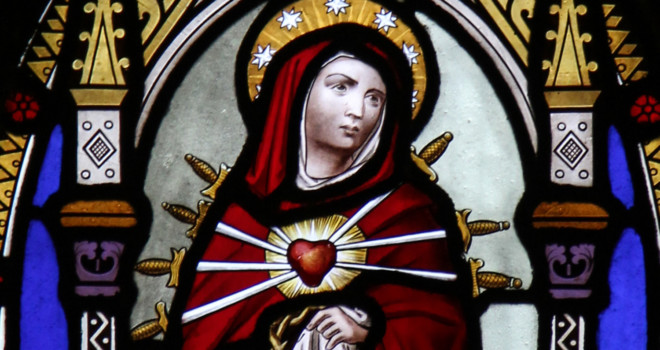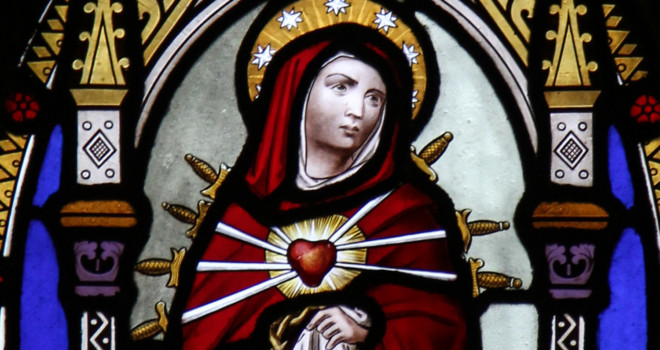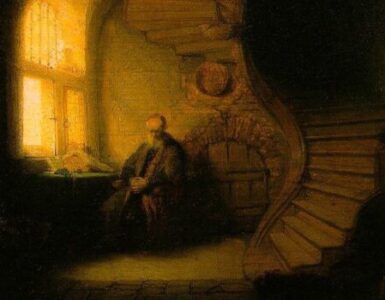Let us turn our minds to the desolation of Mary and the bloody wound that pierces her heart. How is a mother’s sorrow to be understood? Who can depict such deep emotion? Yet if we attend to her, our hearts will speak to us. We must first recall that just as all the joys of the Blessed Virgin come from being the mother of Jesus Christ, so also does her martyrdom. Her love for him was the source of her agony.
There is no need to call the executioner or to stir up the rage of persecution in order to join this Mother to the sufferings of Jesus. It is true that for the holy martyrs it took the rack, the gibbet, and iron nails to imprint upon their bodies the bloody marks of the crucified Christ. For Mary, all it took was love, and we do not understand her love if we fail to realize that it sufficed to cause her martyrdom. Only one Cross was required for both her beloved son and herself. Eternal Father, did you will for her to be covered with wounds? Lead her to the foot of his Cross, and let her love do the rest.
To understand this, we must first reflect upon a mother’s love and then lift our thoughts beyond nature to the Blessed Virgin’s love. We may see a sort of sketch of what grace did in her heart by noting the marvelous character that nature forms in the hearts of mothers. We cannot admire enough the means employed by nature to achieve its end of uniting mothers to their children. That work begins by attaching children to their mother’s womb: nourishment and life are conveyed together. Mother and child run the same risks, and they are, as it were, but one person. Here is a close bond indeed. Should we presume that it comes to an end at birth? No. There is no power that can divide what nature has so well knit together. When the first union comes to an end, another takes its place in the bonds of love and tenderness. The mother carries her child in another way. No sooner has the child come forth from her womb than he is held even closer to her heart.
Let us consider now the eagerness of one mother in the Gospel, the Canaanite whose daughter was tormented by a demon. See her at the Savior’s feet, see her tears, hear her cries, and ask yourself whether you can tell who suffers more, the daughter or the mother. “Have mercy on me, O Lord, Son of David; my daughter is severely possessed by a demon” (Matt. 15:22). She did not say, “Lord, have mercy on my daughter.” Instead she said, “Have mercy on me.”
But if she wanted mercy for herself, she was speaking of her own suffering. No, she says, I am not speaking of my daughter’s torments. Why should I exaggerate my sorrow? If my daughter suffers, then I need mercy. It seems to me as though I were still carrying her in my womb, because when she is tormented, I am troubled to my very depths. Hers is the suffering, but mine is the sorrow. The demon strikes her, but my nature strikes me. We see here the marvelous communication by which a mother is bound to her child, and this suffices for us to understand that Mary’s sorrow knows no bounds.
All that we see in the Canaanite woman is but an imperfect shadow of what we should believe in the case of the Blessed Virgin. Her love was incomparably stronger, and although it is impossible for us to comprehend its extent, nevertheless we can have some idea of it if we seek its principle.
Everyone who makes something loves the work he produces. The same principle that brings us to act also causes us to love what we do, so that the same cause that allows a woman to bear a child makes her able to love the child. If we wish to know what cause brought about the maternal love that unites Mary to Jesus, we must consider the origin of her motherhood.
Tell us, O Blessed Virgin, by what power you came to give birth: was it by the power of nature? No. Rather we see that she had vowed herself to a blessed barrenness by her firm resolution to preserve her purity. “How can this be?” she asked, that I should become a mother, I who have resolved to remain a virgin? Listen to what the angel said to her: “the power of the Most High will overshadow you” (Luke 1:34–35). It is manifest that her motherhood came from on high, and consequently so did her love.
How could nature alone have undertaken to form in the Blessed Virgin the love that she should have for her Son? In order to love God worthily, a supernatural principle is required. Did Mary love Jesus as a man or as the man-God? In what manner would she embrace, in the person of Jesus Christ, the divinity and the humanity that the Holy Spirit had bound together? Nature could not have united them, and faith does not allow us to separate them: what then can nature achieve here? Nature urges Mary to love, and she has all that she needs to love a son, but not what is necessary for her to love God. Yet this son and this God are one, so that nature cannot find the means to prompt her to love this Son adequately.
What remains, then, O eternal Father, but for your grace to come and take powerless nature by the hand? It is you who, having communicated your divine fecundity to Mary, made her the Mother of your Son. Now you must bring your work to completion, and having associated her in a certain sense with the chaste generation by which you produce your Word, you now cause to flow in her veins a spark of the infinite love you have for your only-begotten Son, who is the splendor of your glory and the living image of your being.
This is the origin of Mary’s love. Accordingly, her affliction is without equal. Nothing can produce a similar effect. Hers is a love that passes the bounds of nature, a tender love, a love that unites because it is born from the very principle of unity. The Father and the Son share the same glory in eternity; the Mother and the Son share the same sufferings, the same flood of bitterness. The Father and the Son share the same throne; the Mother and the Son share the same Cross. If the body of Jesus is broken by blows; Mary also receives the wounds. If his head is pierced with thorns, Mary is rent by their barbs. If he is offered vinegar and gall, Mary swallows all their bitterness. If his body is laid out on the Cross, Mary suffers all the violence. It is love that causes this to be.
O love, how heavy do you weigh upon her! O love, how you press upon her maternal heart! This love is a weight of iron upon her chest, which binds and oppresses her so violently that it suffocates her and brings her to tears. This love is a burden because it weighs upon Jesus, while Mary suffers alongside him.
Let us meditate on Mary’s sorrow and labor to imitate her rather than to understand her. Following her example, let us fill our hearts with the Passion of her Son, so that the abundance of our sorrow will forever close the door upon the joys of this world. Mary could no longer endure life: after the death of her beloved, nothing could please her. It was not for her sake, eternal Father, that the sun was eclipsed: there was already no light for the Virgin. It was not for her sake that you razed the foundations of the Temple, nor that nature should bring forth its horrors: after the death of her Son, everything already seemed to her to be covered with darkness. The figure of this world had passed for her, and, to whichever quarter she turned her eyes, she saw nothing but the shadow of death.
The Cross of Jesus ought to do the same for us. If we share his sorrow, the world should no longer have any pleasures for us. The thorns of the Son of God should have torn out all its bloom, and the bitterness that he was given to drink should render its pleasures insipid.
Happy are they, O Savior, who drink your vinegar and gall. Happy are they to whom your shame has made vanity ridiculous, and who have been so firmly nailed to your Cross that they can lift their arms and hands only to heaven! These are the sentiments that ought to move us at the sight of the Cross of Jesus. Here we ought to draw forth a life-giving sorrow from his wounds, a truly holy sorrow, a fruitful sorrow, which will destroy in us the love of this world, extinguish all its brilliance, and lead us to an eternal mourning for the vanities of our past lives.

✠
Editor’s note: This article is adapted from a meditation in Bishop Jacques-Benigne Bossuet’s spiritual classic, Meditations on Mary. It is available as an ebook or leatherette from your favorite bookseller or online through Sophia Institute Press.
image: Seven sorrows of Mary on stained glass in Aberdeen Cathedral / photo by Fr. Lawrence Lew, O.P. / Flickr (CC BY-NC-ND 2.0)















